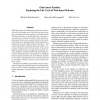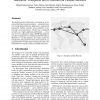NSDI
2008
14 years 3 months ago
2008
As consumer electronic devices with embedded browsers become popular, financial institutions and online merchants set up websites to accommodate visitors using these devices. Thes...
NSDI
2008
14 years 3 months ago
2008
Having decided to focus attention on the "weak link" of human fallibility, a growing number of security researchers are discovering the US Government's regulations ...
NSDI
2008
14 years 3 months ago
2008
Instant messaging (IM) systems have gained a lot of popularity in recent years. The increasing number of IM users has lured malware authors to develop more worms and viruses that ...
NSDI
2008
14 years 3 months ago
2008
Understanding the spammer behavior is a critical step in the long-lasting battle against email spams. Previous studies have focused on setting up honeypots or email sinkholes cont...
NSDI
2008
14 years 3 months ago
2008
NSDI
2008
14 years 3 months ago
2008
In this paper we highlight a number of challenges that arise in using crawling to measure the size, topology, and dynamism of distributed botnets. These challenges include traffic...
NSDI
2008
14 years 3 months ago
2008
We develop new techniques to map botnet membership using traces of spam email. To group bots into botnets we look for multiple bots participating in the same spam email campaign. ...
NSDI
2008
14 years 3 months ago
2008
While the web provides information and services that enrich our lives in many ways, it has also become the primary vehicle for delivering malware. Once infected with web-based mal...
NSDI
2008
14 years 3 months ago
2008
Using statistical machine learning for making security decisions introduces new vulnerabilities in large scale systems. This paper shows how an adversary can exploit statistical m...
NSDI
2008
14 years 3 months ago
2008
The global network of datacenters is emerging as an important distributed systems paradigm -- commodity clusters running high-performance applications, connected by high-speed `la...





